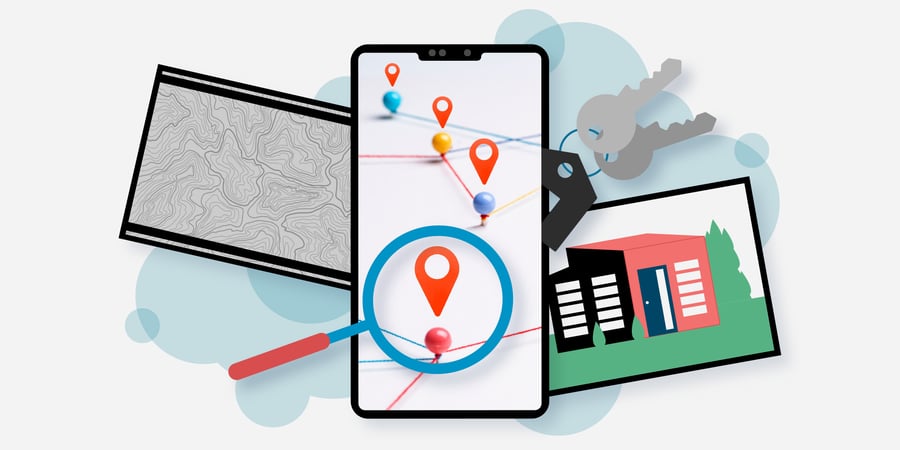How GIS and Esri Products are Revolutionizing the Real Estate Industry

In real estate, Geographic Information System (GIS) technologies are on the rise. In fact, industry use of GIS technology has grown exponentially in recent years, and today, GIS is a staple in real estate. Mapping land development, population trends, property valuations, and facilities management, these are just a few applications of GIS technologies relevant to the real estate industry. In this environment, with its wide array of products, it is no surprise that GIS market-leader Esri is at the forefront of this trend. To illustrate why, here are a few quick examples of how Esri plugs into real estate.
- An informed decision is worth gold, just ask Amazon. Esri's ArcGIS platform and ArcGIS Business Analyst tool combine to provide companies looking to establish a home or move invaluable location-based data and insights. For example, Esri GIS technologies can be used to analyze demographic data and economic trends, identifying areas with the strongest potential for growth and success. Similarly, Esri's Business Analyst tool provides detailed information on the local workforce, consumer population, and regional competition. Finding the perfect headquarter location has never been easier. Which is why Amazon used ArcGIS based data visualization in its HQ2 location search. Using ArcGIS, Amazon was able to compare and contrast how various metropolitan areas compared; how suitable each was based on factors like population growth, labor force education levels, and potential transportation hubs. This information then guided Amazon in establishing their new headquarters in Virginia, and highlights how Esri's strategic approach to data analysis can help companies make smart real estate decisions.
- On the topic of smart decisions, to answer the question whether a piece of land is good or not, Esri has two planning-level maps and map layers on the ArcGIS platform – Irrigated Land Capability Class and Non-Irrigated Land Capability Class. Designed for agriculture professionals looking to optimize land use, these maps cover all of the United States (including Hawaii, Alaska, and Puerto Rico) and help users evaluate the productivity and suitability of land for various types of crops. Allowing further insights into the economic capability of soils, having these maps available on the ArcGIS platform expands the range of tools available to agriculture professionals anywhere in the U.S.. It also exemplifies how Esri technologies help Commercial farmers and farmer brokers to make better decisions, while providing clients with relevant land usage information.
- Esri dashboards are widely used in real estate, and it is a great tool for governments aiming to keep people in the know too. Franklin County, Ohio, for instance, employs dashboards combined with other Esri GIS technologies to improve its property taxation and assessment processes. Mapping property data and tracking trends with Esri software, the county government makes more accurate valuations and ensures that the property tax system is both fair and transparent. It is the perfect example of how Esri GIS technologies, in addition to providing private actors a competitive edge, can help government agencies provide public services benefitting their constituents.
- Esri discussed how its technology has been used to tackle London's housing crisis. Through the use of 3d modeling, Esri is helping local governments and housing developers to better understand the city's housing needs and find solutions to provide affordable housing to residents. Through the use of 3D modeling, London was provided a new way to look at London’s housing capacity, used spatial analysis spots for areas ripe for rooftop development, and ultimately concluded that building up, rather than out, maintains the city’s character and green spaces. The technology has also been used to map out the city's existing housing stock, identify areas of low utilization, and explore the feasibility of new construction projects. By using Esri's mapping and analytical tools, city officials and residential developers are able to make more informed decisions about where and how to invest in affordable housing initiatives.
- In another example of public good, Esri helped The UK gain a birds-eye view in tackling London's housing crisis. Using 3D modeling, Esri provided local government and housing developers a better understanding of both the problem of, and potential solutions to, the city's need for affordable housing. The 3D modeling served as both analysis and visualization tool, and delivered a new perspective on London’s expanded housing capacity. Spatial analysis identified areas ripe for rooftop development, illustrating that building up, rather than out, allowed London to both maintain the city’s character and green spaces, and increase its housing availability. Moreover, Esri mapping and analytical tools were deployed to take stock of the city’s existing housing, identifying areas of low utilization and exploring the feasibility of new construction projects. As a result, London officials and residential developers are able to make better decisions about where and how to invest in affordable housing initiatives.
These are but a few of the many ways GIS and Esri products can provide an edge in the real estate arena. There are many more.

Esri GIS technologies provide the ability to map land use and zoning, allowing real estate professionals to create accurate land use and zoning maps, greatly benefitting their clients. With GIS technology, properties in any given area can be analyzed, and zoning information overlaid on the map, providing a deeper analysis and more vital information to both buyers and sellers. In addition to improving the transparency between buyer and seller, better information also builds trust between real estate professionals and their clients.
Naturally, with more and better information, property valuation gets more accurate with GIS as well. It is another area where Esri and Esri technologies have made significant inroads into the real estate market space. All kinds of data from multiple sources, such as images, satellite data, and physical data, can be used to create detailed property valuations, enabling real estate professionals to provide their clients with an accurate estimate of a property's worth.
As implied earlier, GIS technology also improves the typical client experience. For prospective home buyers, a property’s surrounding area has always played a pivotal role in the decision-making process. With GIS technologies, researching a new home is as easy as identifying the property's location and promptly receiving information on amenities, such as schools, shopping centers, and parks in the proximity. In short, by presenting clients with detailed information about the property’s neighborhood, real estate agents provide clients the tools to make informed decisions when choosing a home.
Taking things to the next level, GIS technology and Esri products can further enhance the client experience by visualizing a home's potential. Augmented reality and 3D modeling adds another dimension, enabling clients to view a home's layout and potential design options before making a purchasing decision. It is the potential first step to making any property a dream home.
Finally, by showing clients a more comprehensive view of a property's history, real estate agents provide the last piece of information clients need to make better informed purchasing decisions. With GIS, information about prior use, previous owners, and environmental factors that may impact a decision is a simple click away.
In conclusion, GIS technology and Esri products continue to revolutionize the real estate industry. Real estate professionals have better tools with which to analyze and monitor property usage and valuation. Buyer’s have access to more and better information, providing them the necessary tools to make better and informed purchasing decisions. Technology is transforming how the industry operates, making tasks more efficient, and ensuring accuracy in data analysis. As a result, we are seeing an improved, faster and more efficient real estate industry better equipped to serve its clients' needs.
I hope you found this blog informative and engaging. At Dymaptic, we're passionate about bringing the power of GIS to the real estate industry, and we believe that collaboration is key to achieving this goal. That's why we are excited to announce that we will be attending the Esri User Conference in San Diego this July. We would love to meet you there and discuss how GIS can further enhance real estate operations and improve decision-making. So be sure to stop by our booth at the conference and say hello. We look forward to seeing you there!




